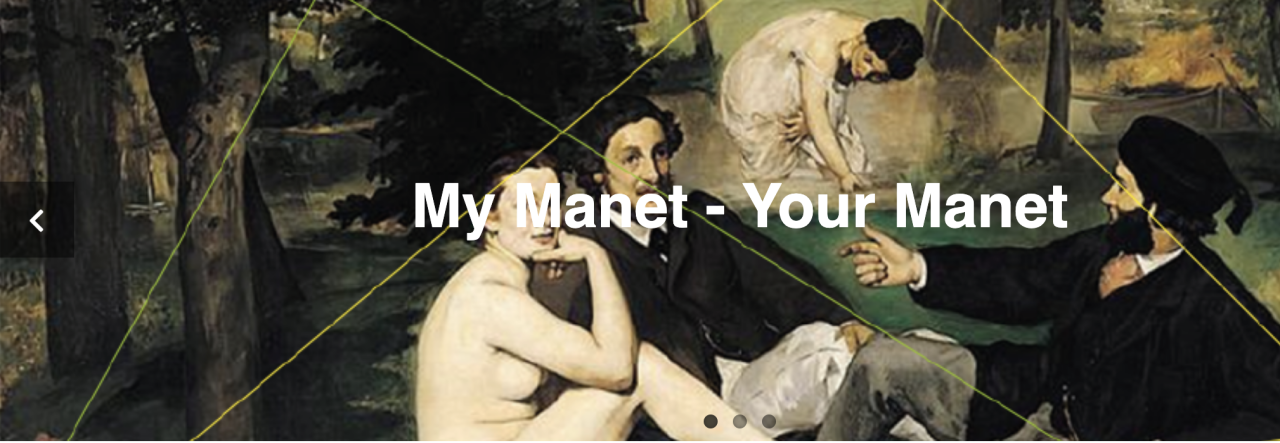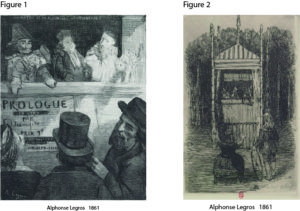Looking back on the first twelve Posts, we notice that I still have not answered my initial question about Why? – about why Luncheon on the Grass has fascinated me about 60 years ago.
Looking forward, I should describe what is next and how I want to go from here.
Let us look at the initial question first, even if a final answer – if there is such a thing – will not be possible. I keep learning about my engagement with Manet.
As mentioned in About, there are some likely factors that could have raised my interests, which did not play an important role in my case.
When I started my hobby, painting in the family kitchen in Cologne, Germany, in the early 1960ies, I was not really interested in art history and knew little to nothing about Edouard Manet.
Even his paintings – speaking to me themselves – made not a great impression.
Perhaps with the exception of Victorine Meurent – the model – looking at me!
Figure 1:
Victorine looking at me – an ink sketch 1982 and digital sketch 2021

It is telling that twenty years later, when I had another “fit” for painting, I started with ink sketches of the figures in Luncheon and other portraits by Manet – and still do …
Actually, I favoured other painters – like Cezanne, Braque, Matisse, or Vlaminck – basically, the next generation of painters agreed to be the founders of modern art.
Besides, my preferences changed over time and included abstract and – later – contemporary painting.
So, the aesthetics of Manet’s paintings, in a narrower sense, were not an important aspect.
Seeing him as a rebel or revolutionary in the development of modern art, was not an attraction either.
My own political interests started later with the “68-movement”, as a student in Hamburg.
I just wanted to paint in my spare time.
So, the attraction must have originated from the form and content of the painting, from the way Manet presented the figures. (And the attraction had little if anything to do with the fact that Victorine was naked. That was a cause for a scandal in Paris a hundred years earlier, but not in Germany after the “sexual revolution” of the 1950ies.)
Two factors might have caught my attention, Manet’s “theatricality” (to use Micheal Fried’s term) and the puzzling social relations in the painting which are disturbing viewers and interpreters to this day.
The theatre played a great role in my life at the time.
My mother was a trained actor, although she was – as a wife and mother of two children – only exercising her profession in a lay theatre. The theatre was, however, of the scope and quality of a large city institution (subsidized heavily by local industry). And I spent much of my time not only in the audience, but also backstage watching rehearsals, assisting in painting coulisses, and operating the illumination during performances.
Many times, I would find myself in a position illustrated in Manet’s Lola de Valence:
Being backstage and looking down at the actress waiting to go on stage, while sitting about 2 meters above her to the right operating the spotlights.
Figure 2: Manet Lola de Valence (1862)

Seeing a theatre scene unfolding in Luncheon on the Grass, therefore, must have occurred to me quite naturally. “Theatricality” certainly was an attractive feature then, and, not surprisingly, it is influencing my interpretation of Manet’s works now – as a puppet theatre.
Concerning the puzzling social relations, a somewhat similar phenomenon happened.
Only well into my professional life as a sociologist I realized that I was attracted to the “formal sociology” of Georg Simmel (1858–1918), a founding father of the discipline around the turn of the century.
However, he was not my favourite.
Simmel made himself a name analysing modern life as it developed at the times of Manet and has influenced art historians. But my interests were in social change and social policy, both not the strongholds of Simmel.
Still, the impact of the formal structure of social relations, the number of people and the patterns of their networks, intrigued me. Simmel was one of the first to systematically analyse the social forms underlying social processes beyond any particular cultural content.
He was a strong advocate of individuality and the expression of individuality in cultural life – in fashion, consumption, media, religion, and the arts. But he was critical of egocentric individualism; he saw the individual intertwined in a network of social relations, forming a pluralism of social circles and distinct realms like science, arts, religion, politics, and the economy.
Society was, in his view, more characterized by diversity than by any unifying cultural idea or socio-economic power.
For somebody like me – not yet influenced by the great ideas and the political dimension of social change – the formal structure in interactions and the conflicting potentials for action was perhaps appealing.
My background in the reality of theatre demonstrated to me that the “content” of the play will change, but the “form” of actors, their costumes and cosmetics, the stage, and the technologies would be similar in the next performance. In sociology, I directed my interests toward urban sociology looking at people on their “stage” in society.
In as much as Manet put his figures on a stage, the actors can change, they are ready to play different parts in different dramas. And somebody has to provide the stage and the illumination…
There is a third factor, which influences my current reflections on Manet more than it probably did back then.
It is linked to Manet’s realism.
Science attracted me more than art; in terms of our discussion of Manet’s realism:
discovery in the spirit of objectivity seemed to be more my thing than expressing my subjectivity.
Manet experienced already the pressure of an enhanced subjectivity and individualism which turned his objectivity in an “attitude” which the impressionists did not share, perhaps with the exception of Edgar Degas (Herbert 1988). But Degas’ objectivity flowed from a dislike for more intimate human relations, while Manet was a sympathetic and social companion with close friends throughout his life.
In some way, I might have sensed that Manet was also choosing the objective over the subjective.
Although for him that meant a choice for self-critical realism and discovery within art; for me it meant a choice for critical realism and discovery in the field of knowledge.
Now, we meet again in the exploration of his art in an objective spirit.
Accepting Manet’s position that his medium is painting and not language or poetry, the common ground has to be the exploration of visual rather than verbal communication.
Accepting his realism, we place the individuals in real life settings, although presented within a “realistic formalism” (Lüthy), or – with the words of Courthion – mankind presented in “composed instants … and the poetry of space in painting” (see previous post).
So, where to go from here?
We keep the spirit of simplicity, sincerity, and naiveté combined with a certain detached objectivity.
And we look at other paintings which present relations between people on a scale which allows their gazes to compose a social space – seeing, being seen, and reflecting on being seen by others.
On this route, we will take the “formal” analysis two steps further.
Comparing the four paintings in Figure 3, we may notice that Manet varies the character of the gaze connecting with the viewer significantly and changes the position on the stage of our four actors.
Figure 3: Gazes and Positions in Manet’s Painting – Four Different Cases

Actually, none of the gazes of the central figures has the somewhat evading expression often considered typical for Manet’s subjects, the prime example for this gaze being the barmaid in Bar at the Folies-Bergeré.
In Luncheon we are offered a rather friendly if non-committing smile; in Olympia the gaze is quite self-assertive keeping own dignity vis a vis the viewer in the possible role of a customer; in The Balcony the dominant gaze (of Berthe Morisot) is not directed at us but into the public sphere; and in Jesus Mocked by Soldiers the gaze of Jesus is clearly turned to his Father beyond the painting.
In the following, we want to consider these differences in the character of gazes, and we want to pay attention to the shifting position of our actors and their gazes in the painting.
For instance: in The Balcony the position of the First looking at us, the viewer, is shifted into the middle ground to the right; in Jesus Mocked the First moves even more toward the back.
Still, in both paintings we find our “crew of four” in the formal scheme, and we should try to apply it and interpret the configuration.
We have dealt with Luncheon on the Grass now extensively. Since Manet appears to think and work in series of paintings experimenting with structural elements (see previous post), we should turn to the next in line. Actually, this should be Olympia which he painted parallel to Luncheon finishing it somewhat later.
I have chosen the rather unknown example of Jesus Mocked which is the next painting in the series presenting a multi-person interaction, because Olympia is already a special case inhabiting only two persons (and a cat).
Remember, there are other kinds of paintings – still lives, portraits, larger settings, and sea- or landscapes.
But Jesus Mocked by Soldiers is the next multi-figure painting and candidate for the proposed “formal scheme”.
Let’s try it out.
See you next week!


